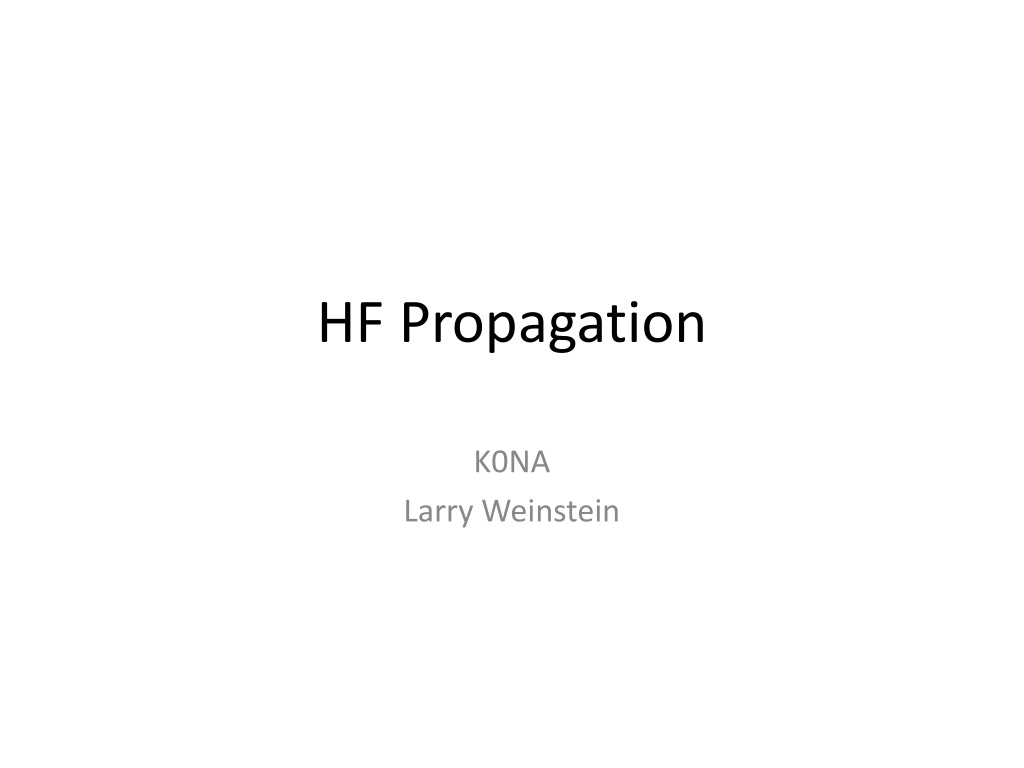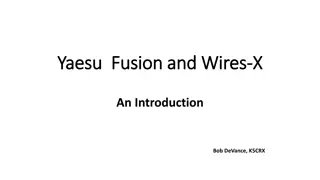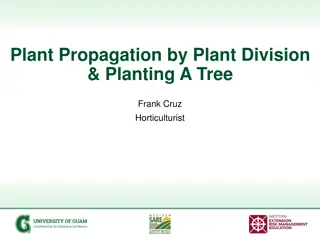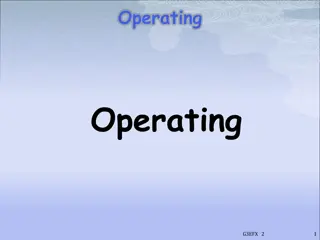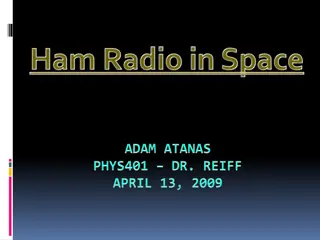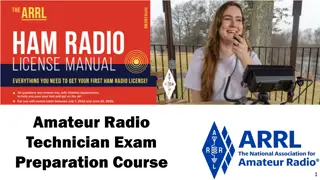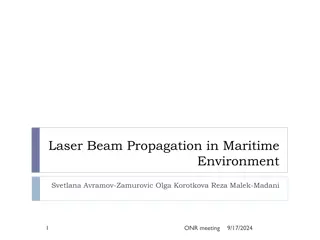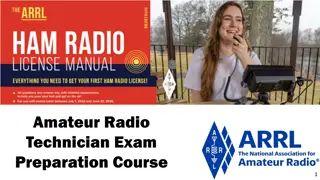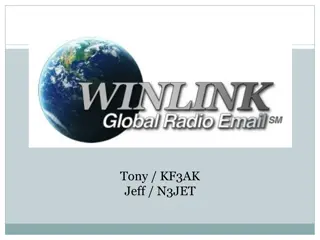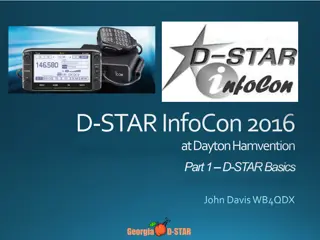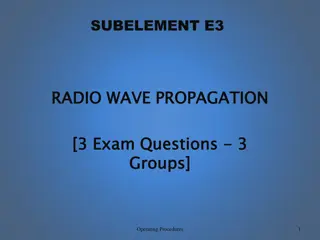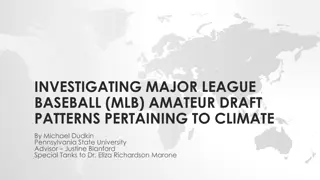Understanding HF Propagation for Amateur Radio Communication
Dive into the world of HF propagation and how signals travel from one point to another in amateur radio communication. Explore topics such as ionosphere basics, critical frequency, practical examples, and the importance of the F2 layer. Gain insights into launching waves, propagation prediction methods, and improving your chances of successful communication.
Download Presentation

Please find below an Image/Link to download the presentation.
The content on the website is provided AS IS for your information and personal use only. It may not be sold, licensed, or shared on other websites without obtaining consent from the author. Download presentation by click this link. If you encounter any issues during the download, it is possible that the publisher has removed the file from their server.
E N D
Presentation Transcript
HF Propagation K0NA Larry Weinstein
HF Propagation You don t need to know anything about propagation to enjoy ham radio We are typically happy to just talk to some one It becomes important when you are starting to chase awards, entering contest, or just have a friend you want to talk to WAS, WAC, DXCC, Field Day, Sweep Stakes, CQWW There are no guaranties you will get the station The purpose of this talk is to improve your chances of success and understand how signals get from A to B A second goal is to give you a qualitative feeling on propagation
Topics Look at launching the wave Ionosphere basics Angle of incidence Critical frequency, MUF, and solar indices Propagation prediction methods Gray line Practical examples
Launching the Wave Transmitter to the feed line Feed line to the antenna If there is a mismatch there will be a reflected wave The feed line has a velocity factor of less than the speed of light The antenna to free space Free space has an impedance of 377 ohms Any mismatch will cause a reflection as in our feed line
Ionosphere layers F1 and F2 Where most of our long distant contacts take place Typical height on a 12 globe .43 E layer No too important for HF communication Typical height on a 12 globe .134 D layer A giant HF sponge Typical height on a 12 globe .043
The F2 Layer Most of the long distance communications takes place in this layer There is almost no air in the in the F2 layer One author said if you would bring all the air down from the F2 layer it would be the size of a basket ball Some of the atoms in the layer are ionized with UV and Xray waves from the sun to create free electrons These electrons move when hit with and electric or magnetic field Moving electrons radiate a signal Reflection vs refraction
Critical Frequency The critical frequency is the highest frequency that can be reflected off the ionosphere from a vertically transmitted pulse Above the critical frequency the electrons are too far apart and pass right through the layer Because atoms are so far apart the many electrons remain free all night
Angle of Incidence Understanding the angle of incidence is important: To understand the maximum usable frequency How much ionization takes place Demonstration
F Layer Dynamics https://www.sws.bom.gov.au/HF_Systems/6/ 5
F Layer Dynamics The ionosphere is very dynamic It is not a smooth shell over the earth Propagation is a statistical challenge Multiple paths are possible as the signal bounces under this low and irregular shell
Other Layers F1 layer Similar to the F2 layer Lower elevation After sunset most electrons find atoms to join up with at lower elevations The layer merges with the F2 layer During this process the ionosphere tilts E layer Quickly disappears after sunset D layer A highly absorptive layer that is a real problem in the daytime for lower frequencies
Angle of Radiation How far you will get is a function of the angle of the transmitted signal Approximate distances vs the angle of radiation for the upper F2 layer Angle Distance 25 degrees 1,000 miles 20 1,600 15 1,800 10 2,200 5 3,000 The point of reflection is about half the skip distance
Height of the Antenna The height of the antenna affects the angle of the signal On 20 Meters Height 20 degrees 10 degrees peak 20 feet 2.0 Dbi -2.7 Dbi 40 4.2 .5 30 60 4.4 2.2 20 100 3.8 6.0 10 Vertical -1.7 -5.2 35 45 degrees
Maximum Useable Frequency The Maximum Useable Frequency (MUF) is the highest frequency that can be reflected at an angle The best signal is typically 10% below the MUF MUF=Fo (critical frequency) / sin(radiation angle) 20 degrees MUF=2.92*Fo 10 degrees MUF=5.75*Fo 1 degree MUF=57.3*Fo ( not realistic!)
MUF at Various Angles 10/27/16, SF=78, SSN=17, A=46, K=5 7PM local MUF for the 1st skip Direction Fo 20 deg 10 deg N 3.5 MHz 10.2 MHz 20.1 MHz E 3 8.7 17.3 S 4.5 13.1 25.9 W 4.8 14.0 27.6
MUF at Various Angles 10/27/16 SF=78 SSN=17 A=46 K=5 7 PM local MUF for the 2nd skip Direction Fo 20 deg 10 deg N 3.1 MHz 9.1 MHz 17.9 MHz E 1.8 5.2 10.4 S 5.8 16.9 33.4 W 6.5 19.0 37.4
Solar Indices Sun spot number Has been measured for centuries Good correlation to the critical frequency Solar flux Measured at 2800 MHz Non ionizing wave length Reasonable correlation to the sunspot number
Geomagnetic Activity The K and A indexes are a measure of changes in the earths magnetic field This greatly affects the polar paths K index Measured every 3 hours A logarithmic scale 0 to 2 is good, 3 to 4 is marginal, 5 up is poor Paths to east, south and west are not greatly affected A index Calculated from the last 24 hours Like yesterdays weather
VOACAP Voice of America Circuit Analyses Program Free open source Is used as the engine in many aftermarket programs One of the best programs out there Does not use the K index Online.voa.com Extremely easy to use
VOACAP Accurate? Testing VOACAP against a WEFAX station from Germany at 10.1 MHz A 10KW station broadcasting 24 hours a day A good indication of the path to Europe on 30 M Predicted and measured signal strength Time predicted measured 0000 utc S3 S4 0100 S4 S5/6 0230 S5/6 S5/6 1200 S1 S0 (below the noise) 1530 S1 S2 (in the Noise) 1930 S1 S2 2230 S4 S3
Can I work Europe on 20 M With my 20 Ft High Dipole? My antenna is only 20 ft high Most of my signal is going strait up What angle will get me into Europe? The optimum is 1 to 10 degrees If I put up a tower, how much would it help? High frequency terrain can answer the question on the next slide Yes Your signal will be about 10 DB lower than if you had a 60 ft high dipole
Colorado to Europe 100 ft dipole 20 ft dipole 60 ft dipole
Gray Line the Great Equalizer At the transition from day to night the ionosphere tilts The tilting ionosphere acts as a huge bill board reflector taking high angle radiation to low angles The effect is most obvious on the low bands On 80 M, I see a 1 to 2 S unit peak The effect is less as one goes up in frequency The effect seems to be the strongest at right angles to the gray line There are 2 peaks, one for you, and one for the other station The gray line eliminates a lot of the competition from other areas
FT8 N0 Decode No Decode No Decode
Propagation to FT4GL Glorioso Island
Tips to Improve Your Chances Pay attention to sunrise and sunset times Monitor the dx spotting nets Monitor who the needed station is working Use VOACAP to see how probable you can work the station Get on the air!
